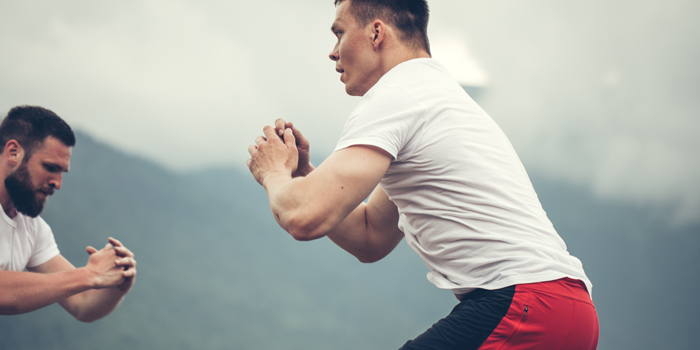
Often, as strength coaches, we look to find correlations for exercises that can build strength. We often look to the weight room to do this, which makes sense as it’s been proven time and time again. The result of lifting weights builds strength, but it can also come at a cost if done improperly. So, having a good coach is of the utmost importance, along with proper programming. Many coaches look for alternative means to build strength that creates less wear and tear on the body and is easy to teach and execute. de Villarreal, Requena, and Newton (2009) used a meta-analysis to look at several studies that addressed if plyometrics can help build strength in athletes. A meta-analysis provides you a much bigger picture of what the literature says about a specific topic. The exclusion criterion for this study was looking for research that implemented plyometric training for lower body training. Anything that involved the upper body was rejected. This left them with 25 initial studies. Next was to look at each study for its internal validity. They looked for studies that included a control group, randomized control, instrument use with high reliability and validity, and experiments with minimal experimental mortality. Fifteen studies were selected after having applied all quality conditions.
RECENT: Sticking Point Breakdown for a Bigger Bench Press
After the studies were dwindled down to fifteen to meet the criteria, within those studies they selected, there were even more variables that they had to screen for. With any program, there are many variables that can dictate the training model. These variables include volume, intensity, frequency, etc. Furthermore, the researchers had to look at all of this, and they decided to break it down to the characteristics of the subjects such as age, height, weight, and previous experience. The program exercises included things like the combinations of the exercise types, the intensity of each session, and the type of plyometric. Program elements included frequency, program duration, drop height, and the number of jumps per session. The outcome measurements included the type of test used to identify progress and the researchers looked for a mean agreement of .94.
The results were measured using effect size, which is a standardized value that permits the determination of the magnitude of the differences between the groups or experimental conditions, with the statistical significance set at p ≤ .05. The results showed the plyometric group was significantly higher with increased strength (0.97; n=24; 24.25kg) compared to the control group(0.11; n = 7; 4.25 kg). They also showed a significant correlation coefficient for body mass (r = 0.451) but no significant correlation for age or group size. Additionally, the results of the ANOVA comparisons were no significant effects. The ANOVA is an analysis variance that is used to examine the categorical independent variables.
de Villarreal, Requena, Newton (2009) found a significant effect regarding intensity and different combinations (p < 0.05) and a positive relationship between frequency per week (r=0.439). No differences were found in the rest of the analysis. The results of this meta-analysis show that plyometric training is an effective method for the improvement of strength performance (ES=0.97) The results also indicated that athletes with more muscle and higher levels of fitness benefit more from plyometrics. This makes sense because muscle is paramount to producing force and moving the body more effectively, so plyometrics may not be best suited for beginners just getting into strength training. A solid base of weightlifting would be better suited for them with a slow introduction to low-level plyometrics and gradually increasing the intensity after some more muscle and strength are developed. An interesting finding of this study was that men and women had comparable gains. This is odd because men tend to have more type II fibers and more muscle mass, but when strength is expressed relative to cross-sectional area, there is no significant difference between sexes. In the search throughout the studies, researchers found that plyometrics used in conjunction with other types of exercise elicited even greater responses in strength gains than plyometrics alone.
In terms of motor learning and progression, there are a few components involved in getting stronger. First, you have a neural component called neural plasticity, (Beach, P, Reid, G, Collier, D. 2018, p. 116). Neural plasticity is the production of a strength response in the very beginning just by doing the movement a certain amount of times just due to the creation of a better connection with those neural pathways. Typically, the more you practice a skill the better you get at it, so having a blocked program that has plyometrics every single day in the very beginning will elicit a faster improvement than if it was random (Beach, P, Reid, G, Collier, D. 2018 p. 350). The other component is that a bigger, more powerful muscle will become a stronger muscle over time. By introducing plyometrics, you will develop power and explosiveness while strength training gives you hypertrophy—the best of both worlds. This is why we see such a vast improvement with the addition of plyometrics. This stage of development would best be suited during Fitts and Posner’s associative/autonomous stage (Haibach-Beach, P, Reid, G, Collier, D. 2018 p. 71-73). Furthermore, a more advanced athlete will get more out of this concept than a beginner who will just benefit from learning the basics of weight training.
I would recommend adding plyometrics in first to get the most out of them. Because they are explosive in nature, you don’t want to do them in any type of fatigued state. This means you don’t want to do them for a bunch of reps with minimal rest, and you don’t want to do them after any other exercises. Having a variety of different kinds of jumps could be of benefit to keep the athletes more engaged and to work different planes of movement using explosive power. Broad jumps, box jumps, med ball throws, plyometric push-ups, single-leg bounds, and side to side skier jumps are just a few you can rotate in for both upper and lower body.
In conclusion, the implementation of plyometrics with a sound exercise routine will promote greater strength gains than not using them at all or using them alone. With the addition of plyometrics, a few things need to be considered, including the extra amount of volume and fatigue they produce, and when to systematically place them in the training cycle. For beginners, it may not be as effective, so focus on building a solid foundation of weightlifting first, then introduce plyometrics later on. From a long-term athletic development standpoint, I would focus on building a solid base with the basic fundamentals of lifting and a small introduction into low-grade plyometrics. This can be done during the first three to five years of their overall development. As the athlete develops further along into an intermediate, you can look to add in some more plyometrics as an adjunct to their strength training routine to familiarize them with the movements and to allow them to develop better body awareness and explosive strength development. When looking to make advances in your strength gains for athletes or for the general population, the addition of plyometrics into your workout is a good idea.
References
- Haibach-Beach, P., Reid, G., Collier, D. 2(018). Motor learning and development (2nd ed). Human Kinetics Publishers.
- de Villarreal, E., Requena, B., Newton, R.U. (2009). Does plyometric training improve strength performance? A meta-analysis. Journal of Science and Medicine in Sport, 13, p. 513-522.











2 Comments